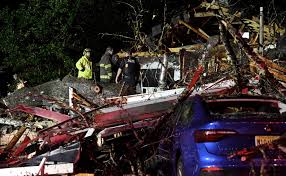
A powerful storm system swept through Texas and Mississippi, spawning tornadoes that caused significant destruction, resulting in two fatalities and six injuries. The National Weather Service (NWS) reported that the severe weather system was advancing eastward, posing further risks to neighboring states, including Alabama. The series of tornadoes left a trail of devastation, damaging homes, uprooting trees, and disrupting power lines.
### Impact in Texas and Mississippi
In Texas, the storm system unleashed a tornado in a rural community, leading to widespread damage. Emergency responders reported that homes were reduced to rubble, and several families were displaced. One of the fatalities occurred in this region, where rescue efforts were hampered by blocked roads and downed power lines. In Mississippi, a second tornado touched down, claiming another life and injuring multiple people. Local authorities described the scene as chaotic, with rescue teams working tirelessly to locate survivors amidst the debris.
### Injuries and Emergency Response
The six injured individuals were transported to nearby hospitals, with some in critical condition. Medical personnel were on high alert, preparing for potential surges in patients as the storm continued to move eastward. Emergency management teams in both states activated shelters for those displaced, providing food, water, and temporary accommodations. The Red Cross and other relief organizations were also mobilized to assist affected communities.
### Severe Weather System Moves East
The NWS’s severe storm tracker indicated that the system was moving eastward into Alabama, with warnings of high winds, heavy rainfall, and potential tornadoes. Residents in the storm’s path were urged to take precautions, including seeking shelter in storm-proof areas and staying updated through official weather alerts. Meteorologists warned that the system could intensify, bringing additional risks to regions already saturated from previous rainfall.
### Community and Government Response
Local officials in Texas and Mississippi declared states of emergency, enabling the swift allocation of resources for disaster relief. Volunteers from neighboring areas joined rescue efforts, providing assistance to overwhelmed emergency services. Social media platforms became critical for disseminating information, with residents sharing updates on road closures, shelter locations, and safety tips.
### Long-term Recovery Challenges
The aftermath of the tornadoes highlights the long-term challenges faced by affected communities. Rebuilding efforts will require substantial financial and logistical support, particularly for uninsured families who lost their homes. The Federal Emergency Management Agency (FEMA) is expected to assess the damage and provide aid, but the recovery process may take months or even years.
### Conclusion
As the severe weather system continues its eastward trajectory, the focus remains on safeguarding lives and minimizing further damage. The tornadoes in Texas and Mississippi serve as a stark reminder of the destructive power of nature and the importance of preparedness. Communities in Alabama and beyond are bracing for impact, hoping to avoid a repeat of the devastation seen in the past 24 hours. Emergency responders and relief organizations are working tirelessly to support those affected, underscoring the resilience and solidarity of communities in the face of disaster.
Be the first to comment